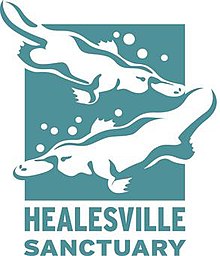Loading AI tools
Zoo in Healesville, Victoria, Australia From Wikipedia, the free encyclopedia
Healesville Sanctuary, formally known as the Sir Colin MacKenzie Sanctuary, is a zoo specialising in native Australian animals. It is located at Healesville in rural Victoria, Australia, and has a history of breeding native animals. It is one of only two places to have successfully bred a platypus, the other being Sydney's Taronga Zoo. It also assists with a breeding population of the endangered helmeted honeyeater.[1]
| Healesville Sanctuary | |
|---|---|
 | |
 | |
| 37.6822°S 145.5316°E | |
| Date opened | 1934 |
| Location | Healesville, Victoria, Australia |
| Land area | 28 acres (11 ha) |
| No. of species | 140+ |
| Website | zoo |
The zoo is set in a natural bushland environment where paths wind through different habitat areas showcasing wallabies, wombats, dingoes, kangaroos, and over 200 native bird varieties.
Guided tours, bird shows and information areas are available to visitors.
Dr Colin MacKenzie (knighted in 1929) set up the Institute of Anatomical Research in 1920 on 78 acres (32 ha) of land formerly part of the Aboriginal reserve known as Coranderrk. The Reserve passed to the Healesville Council in 1927 and became the Sir Colin MacKenzie Sanctuary in 1934.
The first platypus bred in captivity was born in the Sanctuary in 1943 when David Fleay managed it.
The park was placed under the management of the Victorian Zoological Parks and Gardens Board on 27 June 1978.[2]
In 2009, the sanctuary was threatened by the Black Saturday bushfires, and the sanctuary evacuated their threatened species to Melbourne Zoo.[3]
|
|
|
|
|
|
|
|
|
|
|
|
Seamless Wikipedia browsing. On steroids.
Every time you click a link to Wikipedia, Wiktionary or Wikiquote in your browser's search results, it will show the modern Wikiwand interface.
Wikiwand extension is a five stars, simple, with minimum permission required to keep your browsing private, safe and transparent.